Heritage: The Golden Era of Grasstrack
For the decade to 2003, the Thumper Nats was Australia’s most popular motocross series. We reflect on the birth, growth and demise of this iconic era of grasstrack.
With Kevin Williams announcing this week that WEM will officially step down as the promoter of the MX Nationals series at the conclusion of the 2020 season (and as we all ponder the future of lots of racing events and series around the world), we thought it fitting to reflect on one of WEM’s standout achievements: the evolution of the notorious Thumper Nats MX series into what became arguably the world’s best grasstrack motocross spectacle!
NOTE: This content originally appeared in Issue #19 of Transmoto Dirt Bike Magazine in 2012.
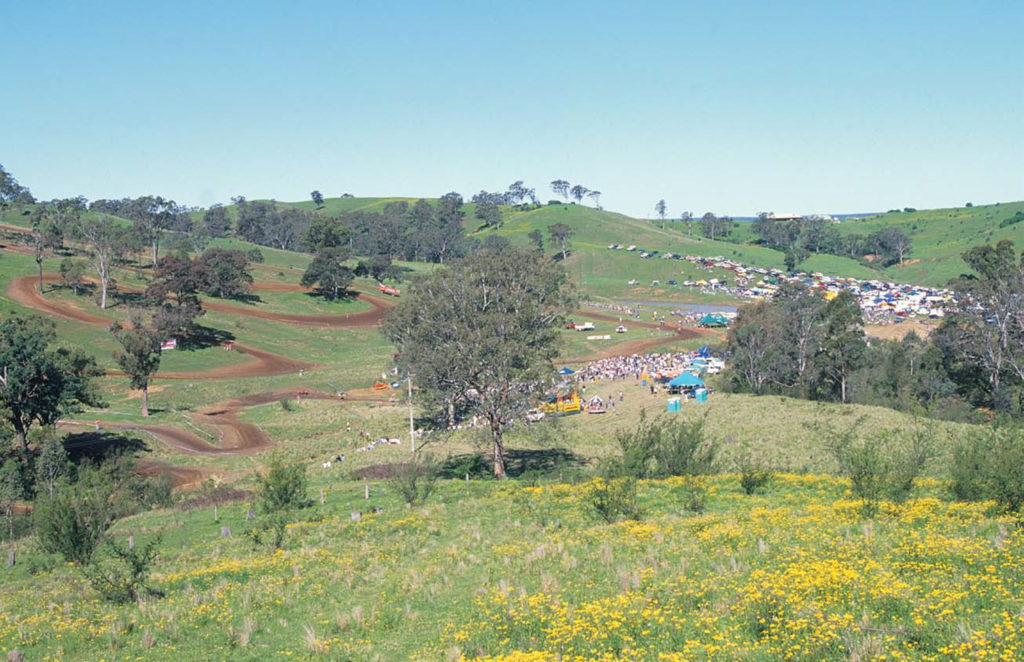
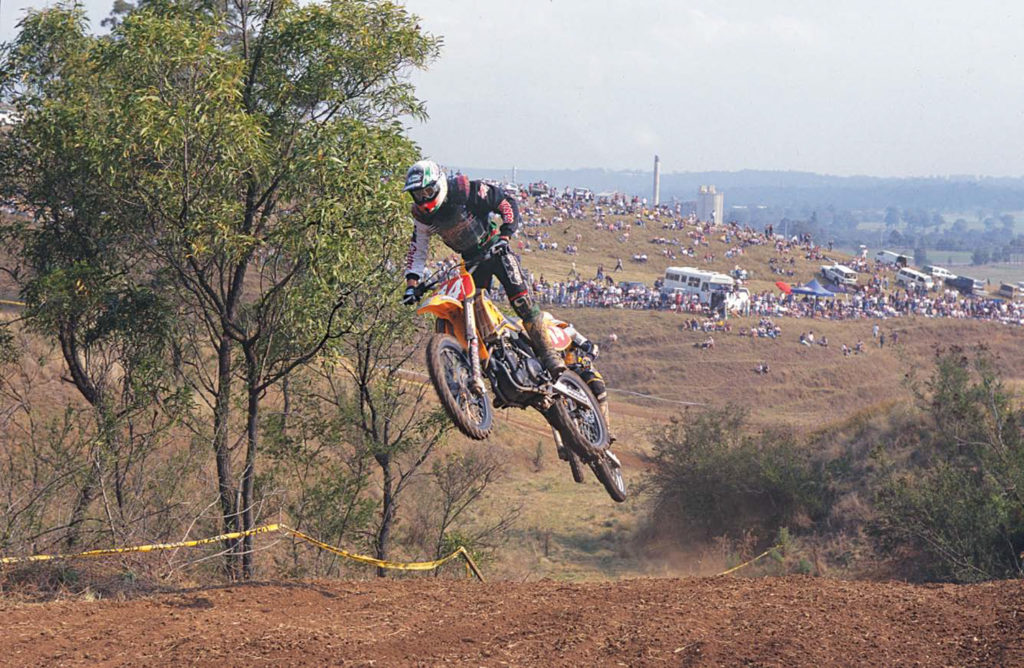
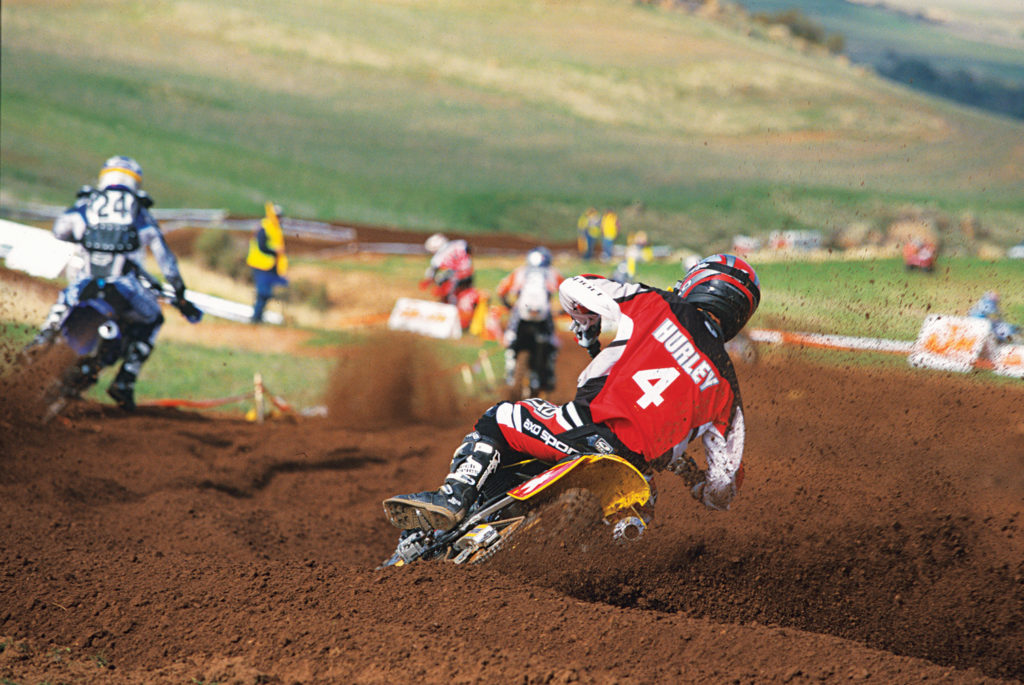
Boulder Park in South Oz religiously produced epic conditions. Hurley chases Kiwi countryman, Darryll King.
Admittedly, there’s a tendency to view the past through rose-coloured glasses. But there was definitely something very, very special about the Thumper Nats. The “Thumpers” was the only national motocross series in the world where punters and Pros would race on the same virgin grasstrack on the same day; the only series where hotted-up trailbikes would do battle with new-gen motocross weaponry; where wily champions of the past would peg themselves against the latest crop of Pro motocrossers; where enduro and motocross riders would mix it up in one massive, fun-filled motocross melting-pot.
The Thumpers embodied that egalitarian, fair-go ethos that runs deep in the Australian psyche, and it attracted thousands of spectators to picturesque rural tracks that were often little more than converted farmers’ paddocks. Yes, the Thumper Nats became a religion for many Aussies during that golden decade of grasstrack between 1993 and 2003, irrespective of which side of the spectator fence you were on.
Ironically, it was the emergence of the new-generation four-stroke motocross bikes that would lead to the Thumpers’ ultimate demise. Along with the onslaught of four-stroke technology in the late-’90s, the series saw an influx of professional race teams. And five years later, when the Australian Motocross Championship had become a four-stroke affair, the decision was made the remove this grasstrack series from the national race calendar altogether.
So, another decade down the track, what legacy does the notorious Thumper Nats leave behind? We spoke to one of the series’ founders, Geoff Ballard, and the man who took it to new heights, WEM’s Kevin Williams, to put those golden years of the Thumper Nats into clearer perspective…
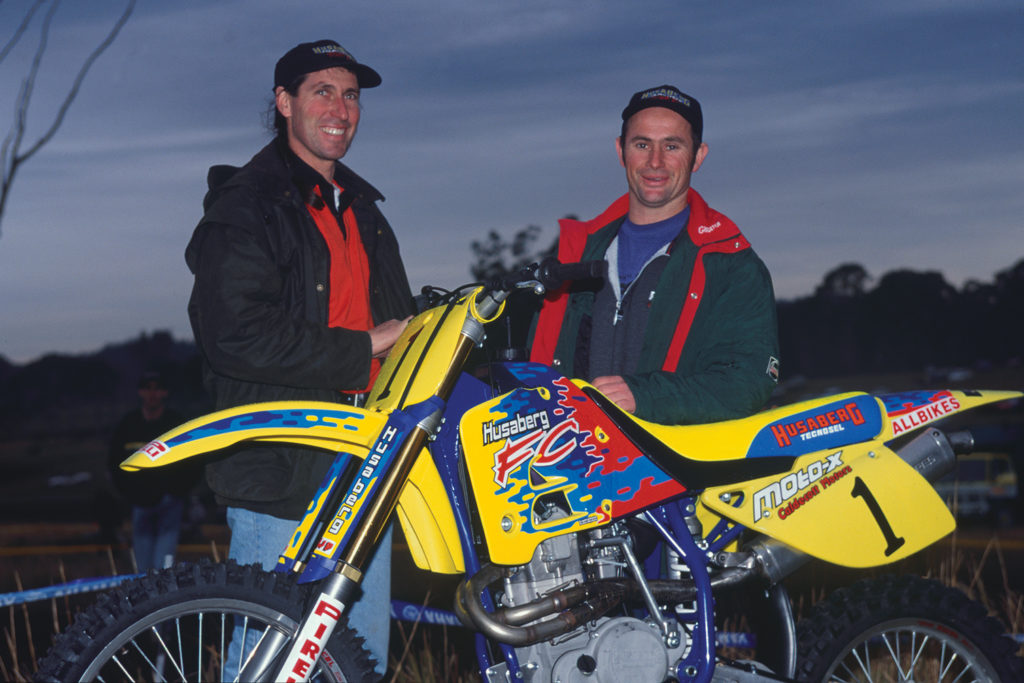
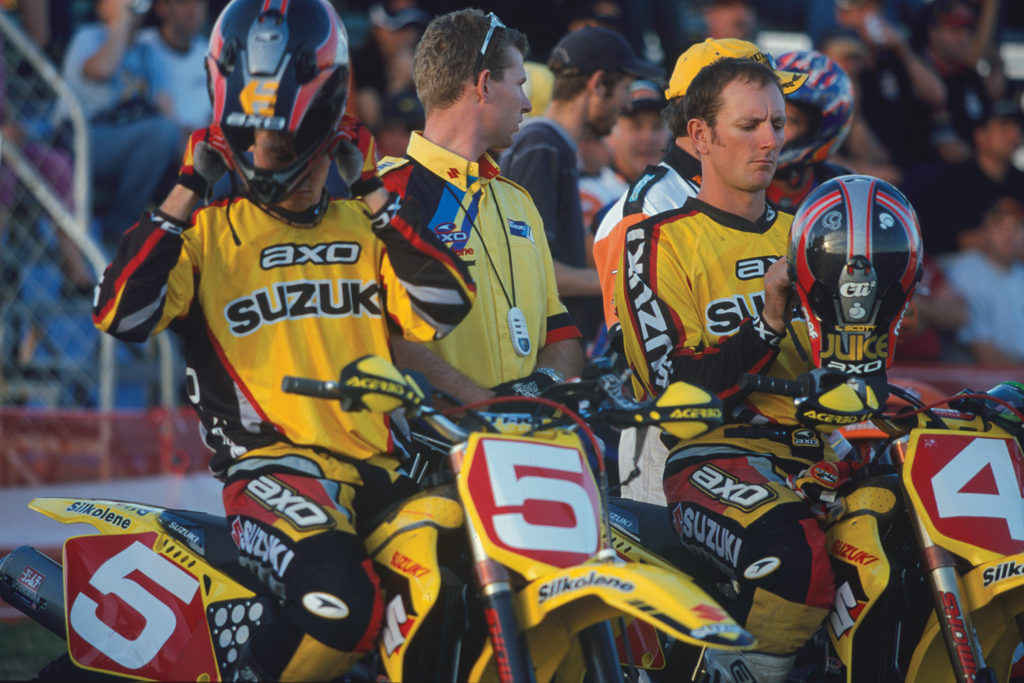
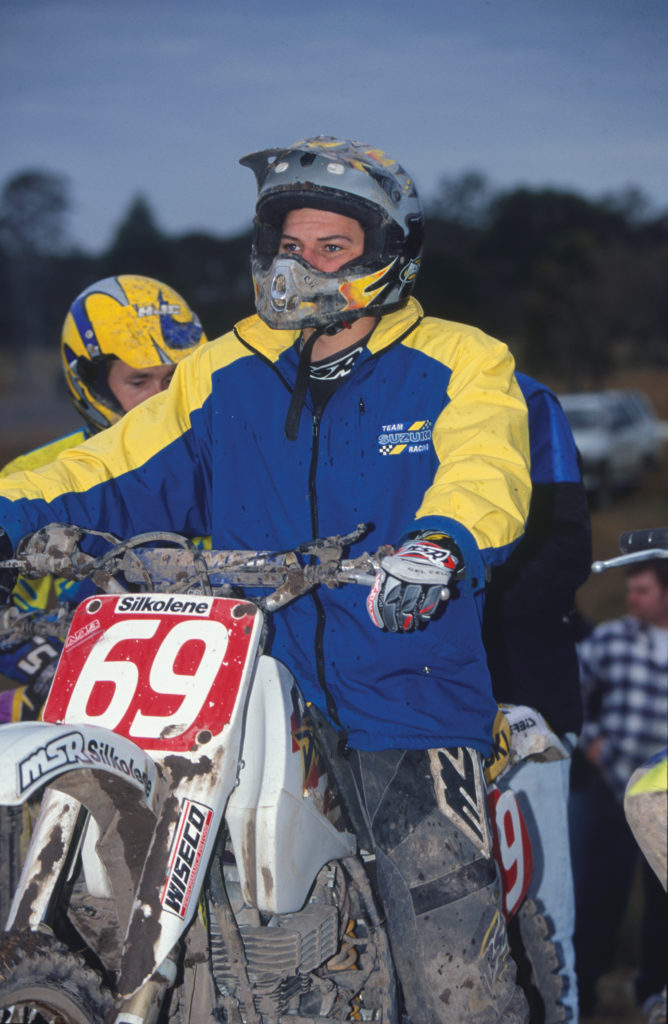
It’s not often you see Chad Reed on a DR250 trailie.
IMMACULATE CONCEPTION
Contrary to what you’d think, the Thumper Nats grew from enduro, not motocross, roots. “The Six-Day is really what started it,” reflects Geoff Ballard, who, along with ADB Magazine’s Geoff Eldridge and Husqvarna importer, Hans Appelgren, were the founding fathers of the Thumper Nats series.
“From the late 1970s, when the Australian teams started travelling over to the ISDE, everyone was just blown away with how unbelievably good their final-moto grasstracks were,” explains Ballard. “We started thinking, ‘Why the hell can’t we do this in Australia? Why do you have to have jumps and berms on a motocross track?’ So that’s how the idea was conceived. The 1992 ISDE in Cessnock – which had a fantastic final moto – accelerated the public’s interest in grasstrack racing, and the ADB Thumper Nats was born the following year.”
The Thumpers was spawned from the idea of injecting fun back into racing and it grew organically, rather than in accordance with a preordained promotional master plan. The founding fathers’ plan was both simple and genius: Ballard was to make the starting gates and set out the tracks, Eldridge would look after the promotional side of the series through ADB magazine, and Appelgren – who was the only one of the trio with a secretary – would manage the administrative side of things.
“The whole thing was about fun,” reflects Ballard. “We knew that if the tracks were good, everyone’d have a great time. We weren’t big on rules, but the core founding principles were that there couldn’t be any prize money; there had to be natural terrain; and there was to be no riding on the Saturday, so there was virgin grass for Sunday’s racing. And the thing really took off pretty quickly.”
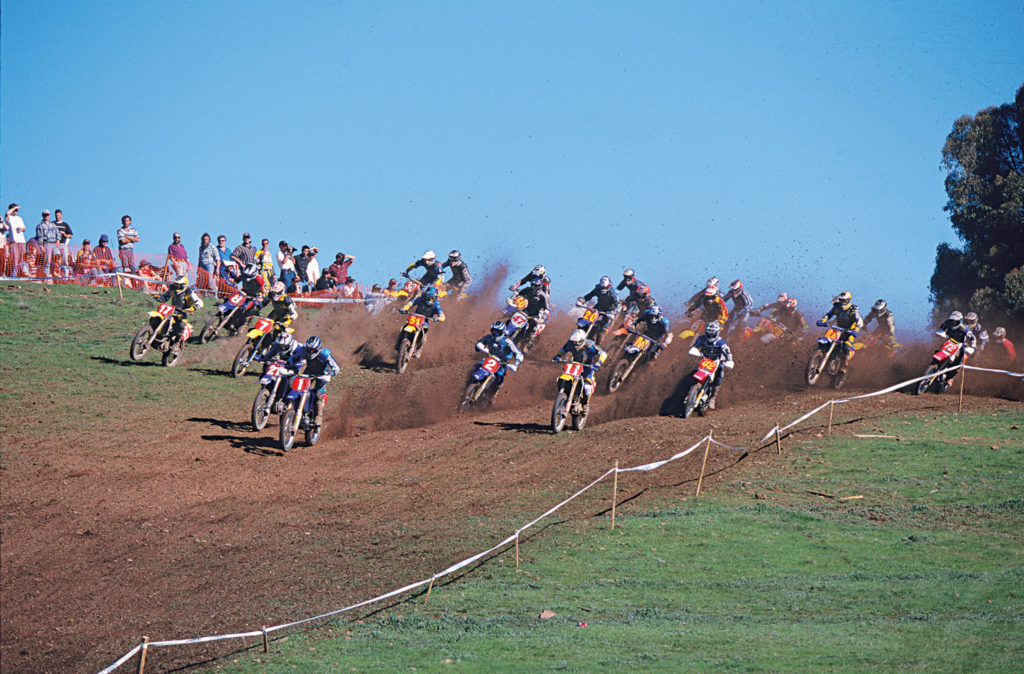
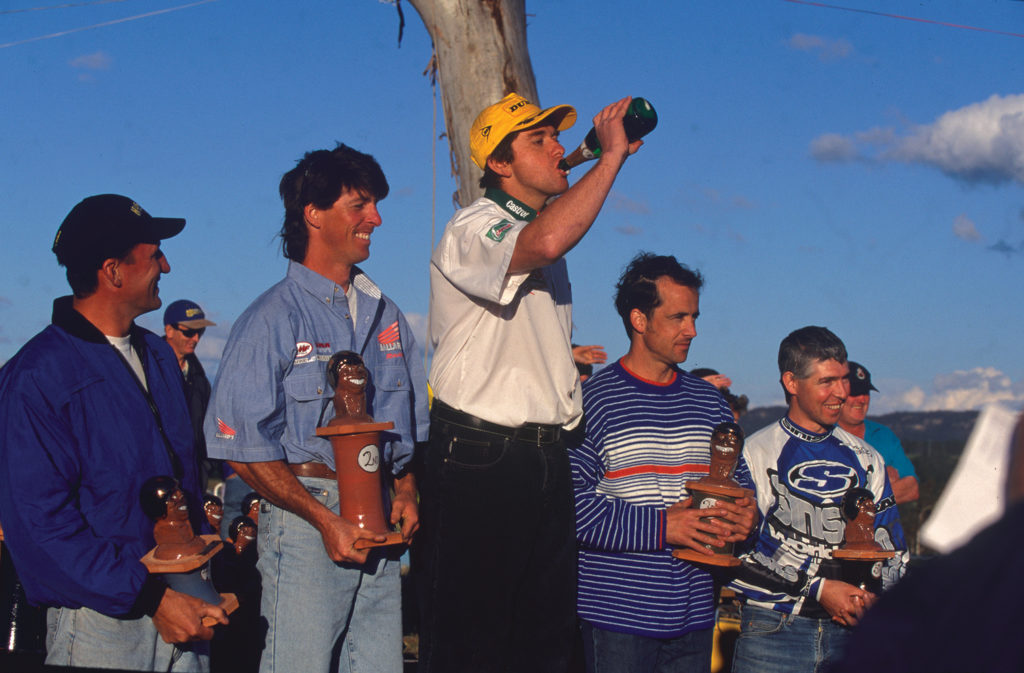
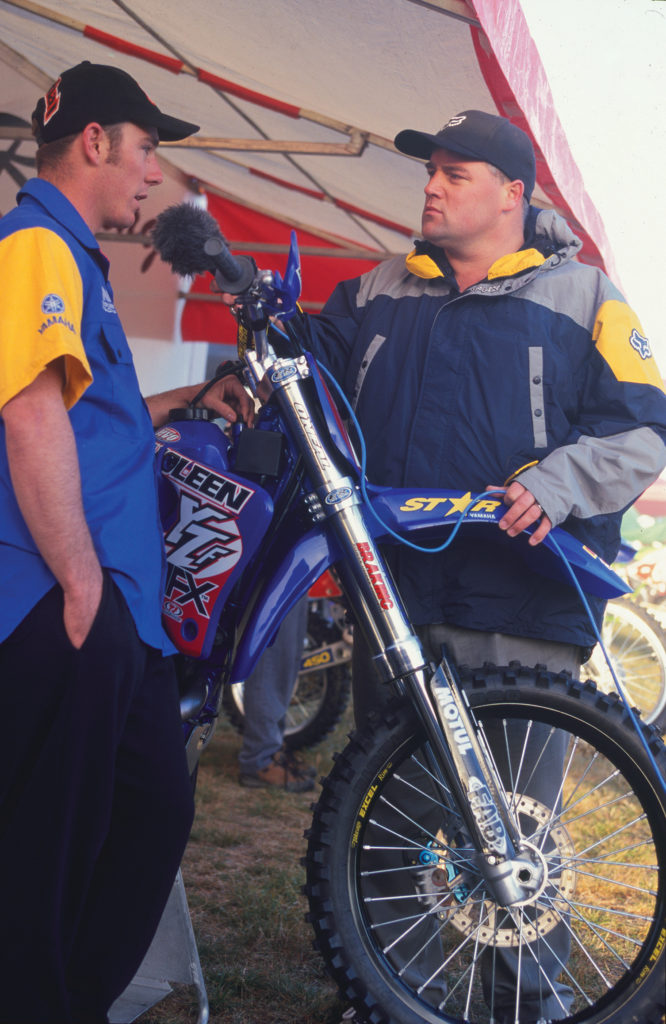
The late Andrew McFarlane with Kevin Williams.
GROWING PAINS
By 1997, with so many guys signing up to race, there was mounting pressure on organisers to race both days of the weekend. But that flew in the face of the Sunday-only, virgin-grasstrack concept the series was founded on.
“We understood why the riders were pressuring us to race on Saturday as well,” says Ballard, “but it’d mean the loamy berms would get powdery and create issues with dust. It just wouldn’t be the same. We didn’t want to compromise the successful formula. I mean, it started out as a NSW-only thing and grew out of control from there. We never thought it’d evolve into a national series. In fact, we almost didn’t want to the Pros to come to the Thumpers; we thought they might spoil it.”
Before long, some of the local manufacturers had even convinced their international superstars to make cameo appearances at the series. “Who can forget when the 1997 World 500cc MX Championships’ winner and runner-up,
Belgium’s Joel Smets and New Zealand’s Darryll King, turned up at Dargle in 1997 and turned it on for the big crowd,” remembers Kevin Williams. “The 1996 World 500cc MX Champion, Shayne King, also rode the Thumpers in the late ’90s. But it wasn’t these internationals who created the Thumpers’ magic,” Williams is quick to qualify. “At every round, you had world-class enduro talents like Ballard, Stefan Merrriman, Shane Watts and the Cunningham brothers mixing it with former motocross champs such as Jeff Leisk, Glen Bell, Dave Armstrong, Lyndon Heffernan, Andy Haydon and Andy Caldecott. These guys were all lured into race the Thumpers.”
In the early years, most guys raced trail-oriented four-strokes with firmer suspension and a front plate in place of the headlight, but it was inevitable that things would get more serious.
“Jeff Leisk was the first to introduce purpose-built four-stroke race bikes in the mid-’90s,” says Ballard. “Up until then, guys had been pretty much racing modified trailbikes – and some were pretty trick.”
They were trick, aright! The Thumper Nats’ pits revealed all sorts of Frankenstein creations, many of which actually proved to pretty damn handy grasstrack weapons. Glen Bell was getting around on a Ballard’s XR630 with an alloy tank and very few recognisable XR parts. Peter Melton raced a stripped-down KLX650 behemoth. The guys from Cisco’s cobbled together a WR250F before one ever even existed for Jason McGuinness, using a combination of ATK, CCM, KTM and Yamaha TTR parts. Andrew McFarlane won a title aboard a Kevin Doyle-created KLX250 with more compression than an atomic bomb. Craig Anderson made his big KTM 620s do things they clearly weren’t designed to do. Daryl Hurley and Paul Broomfield rode those trick Suzuki DR-Z400s, mated with RM suspension and subframes and carbon/kevlar fuel tanks. And Michael Byrne took a Pip Harrison-fettled XR650 to an Outright win in 2000, ahead of the more fancied new fire-breathing YZ426Fs – ridden by Chad Reed and Daryl Hurley – and Craig Anderson aboard KTM’s new 520SX. They were just some of the fascinating machines raced in that era. Other blokes went down the easier – but more expensive – route of shipping in factory-replica Husaberg and Husqvarna motocrossers from Europe. Usually big-bores, too.
By 1999, the writing was on the wall; high-performance motocross bikes were here to stay. And as the other manufacturers clambered to bring their version of the YZ400F to market, they would collectively change the Thumper Nats forever. “Without prize money, the Pro guys initially weren’t interested in the series,” recalls Ballard. “But by the late ’90s, the manufacturers were contracting their riders to race their new four-strokes in the Thumpers and paying them big contingency money. Suddenly, the race team semi-trailers had to find a way to get into these farmer’s paddocks and the amateur feel of the series began to shift. We never made a cent out of it; we just loved racing the thing and seeing others get so much enjoyment from it. But it had become too big to do as a sideline to our businesses,” Ballard goes on to explain.
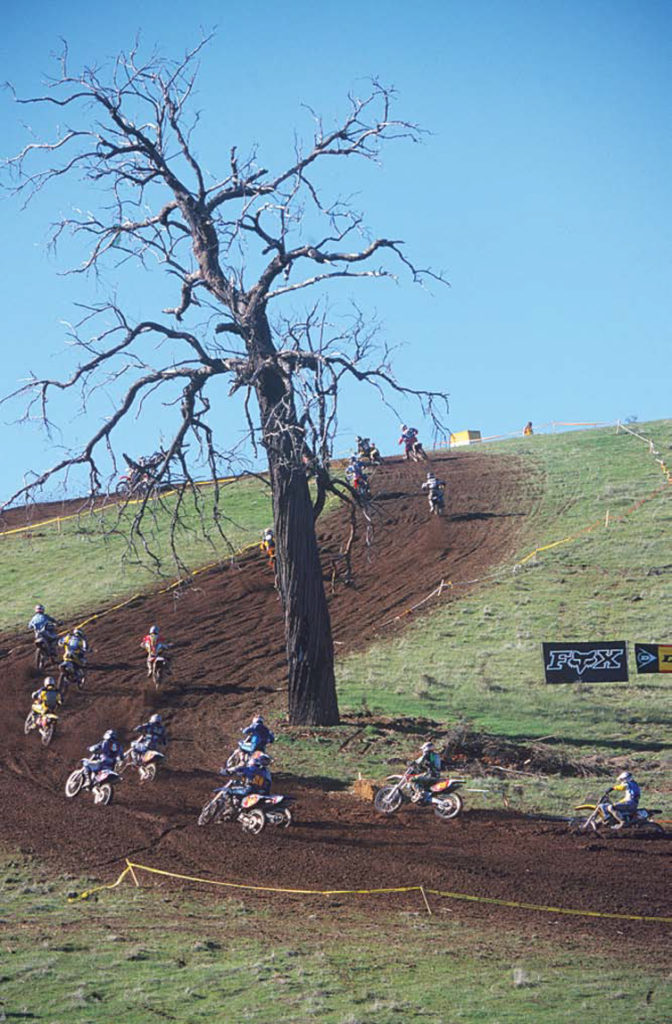
Would you prefer a track with gnarly jumps, or this? Yep, the choice was clear for riders of all ages and abilities: grasstrack.
THE HANDOVER
By 1997, Williams Event Management’s (WEM) Kevin Williams had begun helping host clubs with the marketing, promotion and coordination of the Australian Motocross Championship, which was just five rounds back then. So when the Thumper Nats’ organisers were looking for someone to take on the series, Williams was the obvious candidate. And in 1998, the series came under WEM’s auspices.
“At that time, the clubs were predominantly running the series. But without a coordinating entity, it became difficult to grow it coherently,” recalls Williams. “We proposed that we centralise things like the entries to take some workload away from the clubs. And we went out and found sponsorship to fund the additional expenses. Obviously, we worked with the Thumpers’ founders initially to ensure the series direction was consistent with their wishes.”
But WEM’s arrival coincided with that of the new-generation four-strokes, and this proved to be both a blessing and a curse for Williams. On the one hand, the Thumpers provided manufacturers with the perfect opportunity to showcase their new-generation four-strokes. On the other, the non-intimidating vibe of the pits changed with the arrival of Pro riders and teams.
“When we first took over the series, it wasn’t about the Pros,” explains Williams. “The Thumper Nats was a series created by riders for riders; to really enjoy getting out there and racing a motorcycle. It had started as a NSW series, but evolved when other venues put up their hand. And within a year or two, the modified trailbikes everyone was riding were up against the rapidly emerging high-performance four-stroke MX bikes. The economy and the dirt bike industry were both very strong back then, so the Thumper Nats gave the manufacturers a platform to market their new four-strokes. That’s what fuelled its growth.”
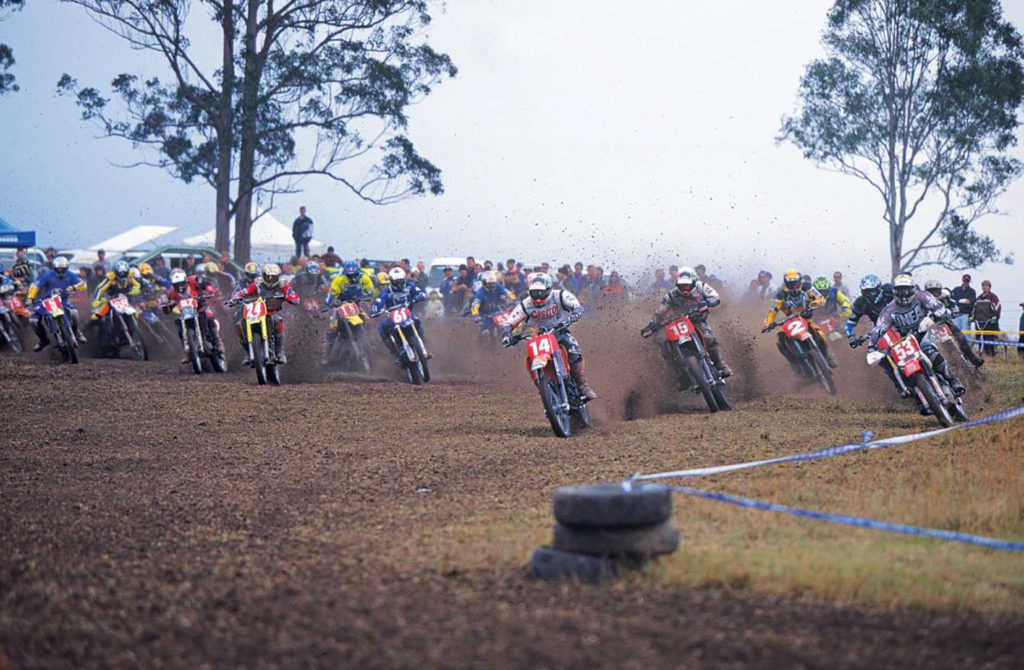
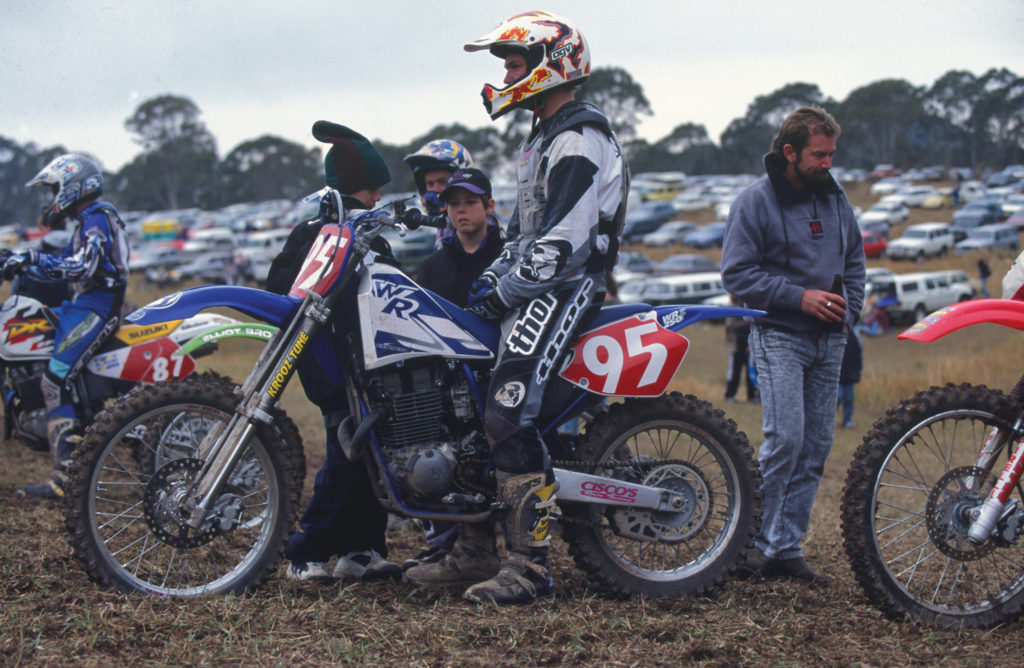
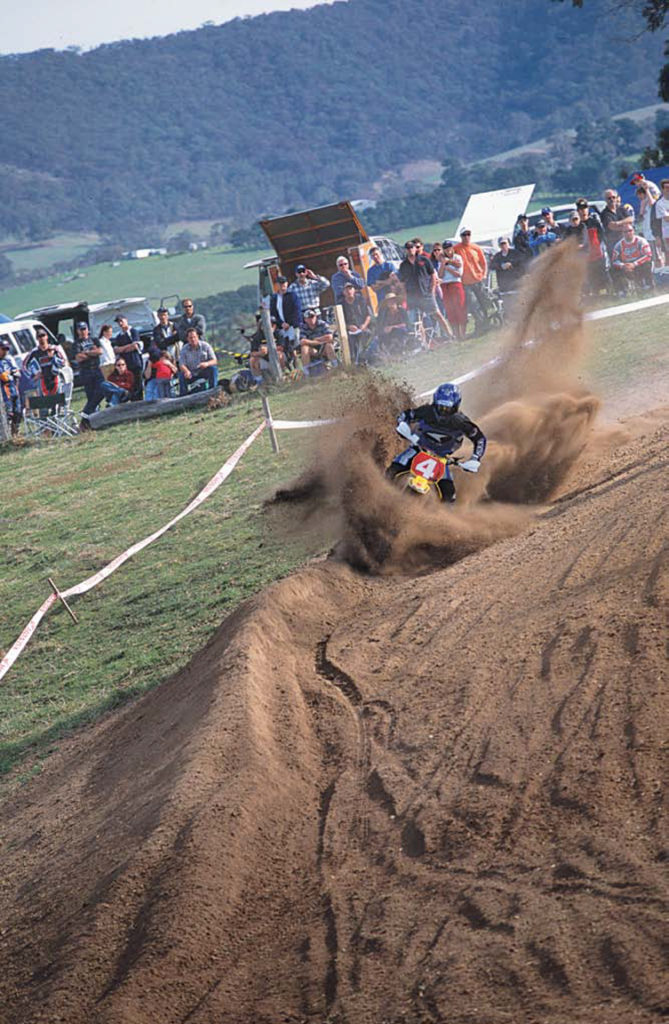
Still without a four-stroke MX bike in 2001, Suzuki’s Daryl Hurley was forced to ride an RM-ified DR-Z400. Lithgow loamtown!
WRITING ON THE WALL
But as Joe Average’s ute and box-trailer was gradually replaced by privateer race teams and Pro team big-rigs, WEM was forced to juggle the often conflicting demands of the Pro riders and the grassroots guys it was originally conceived for. At which point, driving 15 hours from NSW to South Oz for a couple of 10-minute motos stopped making a whole lot sense for the average Clubman, and series entries began to taper off.
“I think we maintained a pretty good balance for the Pro and amateur guys,” Williams says. “But by 2001 or 2002, when most manufacturers had weighed in with their high-performance four-stroke motocrossers, the concept of having two independent national series to race exactly the same bikes simply didn’t make sense any more. The other factor that began to work against the Thumpers was the growing OH&S legislation to ensure the safety of the spectators.”
In other words, the idea of bunting off a grasstrack and allowing spectators to stand behind it simply didn’t wash from a safety perspective. “The bikes were getting faster and these greenfield sites were becoming expensive to operate,” says Williams. “Some clubs made good money from staging a round of the Thumpers, but didn’t even have their own venue to spend it on.”
With the two series stepping on each other’s toes, it was inevitable one would have to go. “From a spectator’s point of view,” explains Williams, “the Thumper Nats and Australian Motocross Championship had converged and were delivering very much the same show. So, in agreement with the manufacturers, we moved to one national motocross series in 2004, comprising several more rounds and with a philosophy of further developing venues and clubs for the long-term. Sure, we went to some fantastic venues for the Thumper Nats series, but there was no physical legacy after a Thumpers round. A farmer’s paddock was never going to be a long-term venue. In 2012, WEM is going into its 16th season promoting the Australian Motocross Championship, and – as it has been the case for many years – our focus remains on helping to develop venues that’ll be around for future generations to enjoy.”
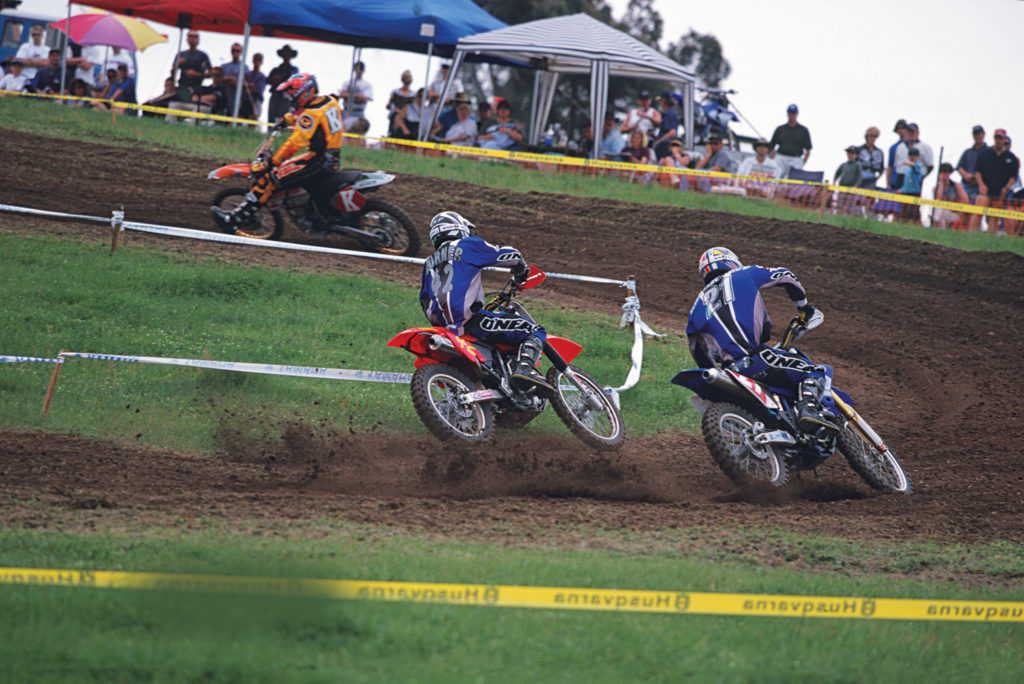
Michael Byrne and Andrew McFarlane chase former world 500cc champ, Shayne King.
THE THUMPERS’ LEGACY
While many still lament the sudden disappearance of the Thumper Nats, it’s clear that the model wasn’t sustainable. But how do the guys responsible for the series’ birth and phenomenal growth reflect on it?
“There were a lot of things that contributed to making the Thumpers what it was,” says Ballard. “It was the atmosphere, the noise of a gate-full of big four-strokes, the fast and flowing tracks, and the fact spectators could get close to the action. People could relate to what they were seeing. It brought racing within the reach of many more people, and it brought to life their dreams about racing around a golf course! And there is absolutely no doubt the series taught our top Pros how to keep their corner speed up around flat turns. When the Pros first turned up at the Thumpers, they’d been so used to berms, they were getting beaten by guys who wouldn’t get near them on more conventional MX tracks.”
According to Williams, “The Thumpers drew people from all walks of life. They’d travel all over the country to be part of it and enjoy a great weekend away. Irrespective of your skill level, you could go out and race in the Thumpers and have a ball. There were classes for all abilities and ages, so you didn’t have to be super-fit and highly skilled. It was like your local club day, but at a national level. The camaraderie was amazing, and it gave riders the unique opportunity to race on the same track as world-class Pros. And it gave several clubs their first taste of running a national.”
So why doesn’t WEM or someone else go and do it again? “Quite simply,” concedes Williams, “because I don’t want to end up in court. For tracks where there’s no permanent fencing, it’s difficult and expensive to comply with OH&S regulations, and it can be extremely hard to obtain all the permits to satisfy local councils.”
Oh, but how we’ll miss the rolling hills of Barrabool’s McAdam Park, the luscious loam of Conondale’s Green Park, the natural gullies of Picton’s Razorback Mountain, the red sands of Mannum’s Boulder Park, and all those other mouth-watering venues at Albury, Hartley, Junee and Kempsey, where farmer’s paddocks were transformed into a moto Mecca, just for the weekend. Just for the Thumper Nats.
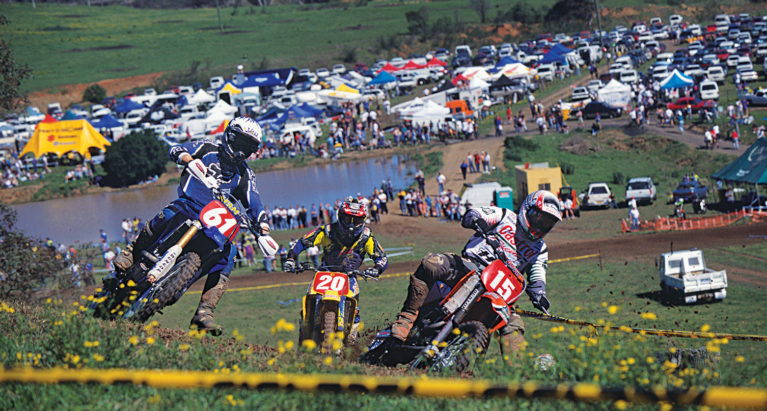


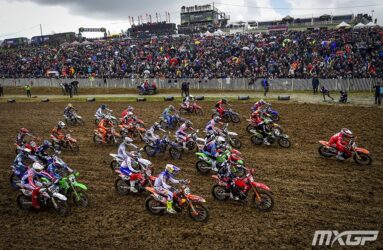
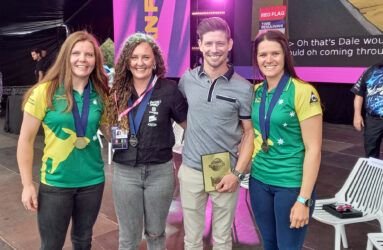

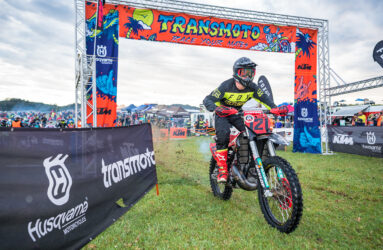

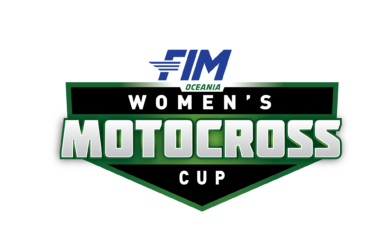
Be the first to comment...